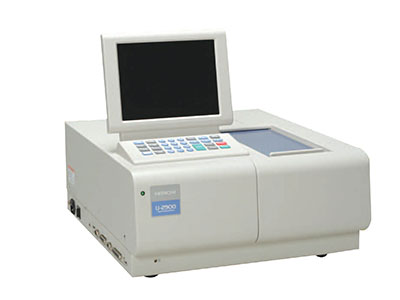Hits: 5236
UV Spectrometer
Hits: 5236

Hits: 5236

Hitachi Double Beam Spectrophotometer Model: U2900 / U2910
Spectrophotometer simpler to use and higher in dependability thanks to mounting of a large-size color LCD.
High resolution satisfying European Pharmacopoeia (spectral bandpass: 1.5nm). Trace-amount measurement in biotechnological field, etc. can be carried out using optional 50, 25 and 5mL micro-volume cells.
- An abundance of optional accessories for various applications have been lined up.
- Function for automatic data storage in a USB memory is incorporated.
- Validation function and self-diagnostic function are standard with this instrument.
- The UV Solutions control program available at option enables the user to control operations from a personal computer. (The Model U-2910 is a special model for PC control.)

Hitachi UV-VIS-NIR Spectrophotometer Model: UH4150
OPTICAL SYSTEM
Double Monochromator Prism-Grating Optical System
Offering low polarization effects and low noise measurements
The UH4150 adopts a prism-grating (P-G) double monochromator optical system, continuing the established reputation of the U-4100 optical system. Large changes in light intensity of the S and P polarization are less likely for the prism-grating (P-G) system than for the generally used grating-grating (G-G) system. The UH4150 offers low noise measurements, even for low transmittance and reflectance samples.
Collimated Light Beam advantage
High-accuracy specular reflectance measurement
The incident angle is important for the measurement of specular reflectance of solid
samples. For focused light beam, the incident angle varies depending on the lens’s focal length, etc. Consequently, the values of simulation of design of optical thin films, such as dielectric multilayer film and prism, would differ from actual measured values. In the case of a collimated light beam, however, the incident angle is always the same with respect to the sample, leading to a highly accurate measurement of specular reflectance. Moreover, the collimated light beam is useful for the evaluation of diffusivity (haze) and the measurement of transmittance of lenses.
Offering low polarization effects and low noise measurements
The UH4150 adopts a prism-grating (P-G) double monochromator optical system, continuing the established reputation of the U-4100 optical system. Large changes in light intensity of the S and P polarization are less likely for the prism-grating (P-G) system than for the generally used grating-grating (G-G) system. The UH4150 offers low noise measurements, even for low transmittance and reflectance samples.
Collimated Light Beam advantage
High-accuracy specular reflectance measurement
The incident angle is important for the measurement of specular reflectance of solid
samples. For focused light beam, the incident angle varies depending on the lens’s focal length, etc. Consequently, the values of simulation of design of optical thin films, such as dielectric multilayer film and prism, would differ from actual measured values. In the case of a collimated light beam, however, the incident angle is always the same with respect to the sample, leading to a highly accurate measurement of specular reflectance. Moreover, the collimated light beam is useful for the evaluation of diffusivity (haze) and the measurement of transmittance of lenses.

Difference at Detector Switching due to Signal Level Suppression
Improved accuracy in the visible to near infrared spectral region
Multiple detectors are installed in the integrating sphere to perform measurement over a wide range of wavelengths, from ultraviolet to visible to near infrared regions. The changes in photometric values at detector switching (from signal level differences) are minimized due to a design utilizing Hitachi’ s expertise in integrating sphere construction, signal processing technologies, etc.
SAMPLE COMPARTMENT
Large Sample Compartment of 680 (W) × 470 (D) × 300 (H) mm
Improved accuracy in the visible to near infrared spectral region
Multiple detectors are installed in the integrating sphere to perform measurement over a wide range of wavelengths, from ultraviolet to visible to near infrared regions. The changes in photometric values at detector switching (from signal level differences) are minimized due to a design utilizing Hitachi’ s expertise in integrating sphere construction, signal processing technologies, etc.
SAMPLE COMPARTMENT
Large Sample Compartment of 680 (W) × 470 (D) × 300 (H) mm


SYSTEM COMPATIBILITY
Compatibility with Model U-4100: Accessories common to both models and Software common to both models
Advancements from Model U-4100: Improved measurement throughput
Increased Offering of Detectors
Advancements from Model U-4100: Improved measurement throughput
Increased Offering of Detectors

APPLICATIONS Transmittance Measurement

Reflectance Measurements


Hitachi Double-Beam Spectrophotometer Model: UH 5300
Feature
Smart Use of long-life xenon flash lamp Light source is guaranteed for seven years*4, resulting in lower operation cost Double-beam optical system Ensures extended periods of data stability compared with the single-beam optical system
Simple Operation by use of tablet terminals Simple and intuitive user interface Remote control through wireless communication Flexible operating environment
Easy Simple and easy-to-understand performance check function Assures the accuracy of data Automatic 6-cell turret as standard equipment Improved efficiency and increased ample throughput
Smart Use of long-life xenon flash lamp Light source is guaranteed for seven years*4, resulting in lower operation cost Double-beam optical system Ensures extended periods of data stability compared with the single-beam optical system
Simple Operation by use of tablet terminals Simple and intuitive user interface Remote control through wireless communication Flexible operating environment
Easy Simple and easy-to-understand performance check function Assures the accuracy of data Automatic 6-cell turret as standard equipment Improved efficiency and increased ample throughput
Contact us
Syntech Innovation Co., Ltd.
388/5 Nuanchan Road, Nuanchan,
Buengkum, Bangkok 10230
388/5 Nuanchan Road, Nuanchan,
Buengkum, Bangkok 10230
0 2363 8585 (auto)
0 2363 8595
081 498 9939

2986428
Today
Yesterday
This Month
All days
653
2991
36327
2986428
Your IP: 216.73.216.167
2025-12-19 12:00





